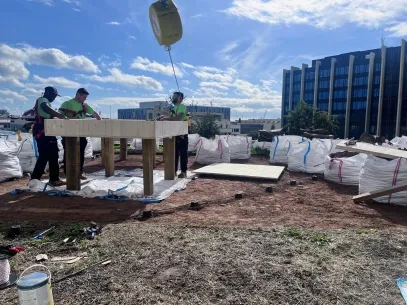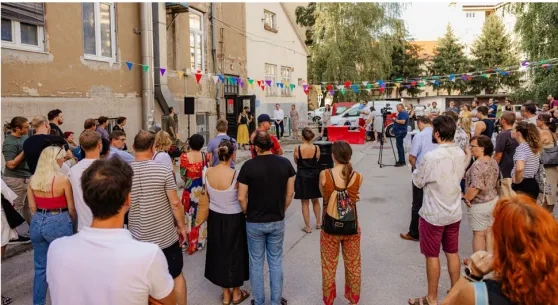
Introduction
This final chapter summarises the key findings from this work. It includes the conclusions drawn from the research and fieldwork as well as a set of recommendations, packaged as a roadmap for cities. This draws upon the shared characteristics of most effective UIA cities promoting Just Transitions through their work on jobs, skills, and emerging green sectors.
The roadmap has been produced to support other cities looking to learn from the UIA experience. At a systemic level, it is also encouraging to note that the successor programme, European Urban Initiative-Innovative Actions (IA-EUI[1]), will also comprise (b1) support of capacity building and (b2) support of knowledge building, territorial impact assessments, policy development and communication, therefore there will be greater scope to replicate future successful innovations that promote Just Transitions. The new EUI structure should also support closer links between the innovation fund and mainstream Cohesion Policy programmes, enhancing the potential for scaling and mainstreaming.
[1] The successor initiative, IA-EUI, will form an integral part of the new European Urban Initiative (EUI) in the 2021-2027 programming period.

1. Final key messages
Although their primary focus has not been Just Transitions related to the changing labour market, this study identified 24 UIA projects whose work is impacting on this important area. It is encouraging to hear that the majority of those are confident that their city will transition to climate neutrality without leaving anyone behind. However, they identified a consistent set of challenges that might inhibit this.
In addition, 70% of these cities thought that specific sections of the community were more at risk of being left behind. There was a high degree of consistency around this profile which included the low-skilled, women, older workers and young people. Citizens with a precarious connection to the labour market were also singled out, particularly as the pandemic has highlighted their vulnerability. The threat of widening urban inequalities as a consequence of the transition to climate neutrality is quite clear.
In a fast-changing labour market that is being transformed by the megatrends of green and digital, it is evident that the absence of structural, real-time information on occupations presents a major challenge for job seekers and employers. Misconceptions about the nature of ‘green jobs’ compounds this, creating the potential to exacerbate already high levels of skills mismatches in cities.
However, it is notable that of the three sub-themes within the scope of this work, skills forecasting had by far the fewest examples across the approved UIA projects. This is likely because few cities have the skills to do this in house and the work itself is complex and costly. Nevertheless, without a solid understanding of the future skills perspective, cities are already on the back foot when attempting any coherent approach to local labour market planning related to the green economy.
The handful of cities active in this space provide valuable learning for others. Eindhoven’s work can be described as truly ground-breaking at the European level, through their ambitious creation of a new skills taxonomy using the O*NET framework. This has produced a granular understanding of occupational areas linked to the city’s growth sectors. Combining this with a gamification approach has enabled city partners to work more effectively with those further from the job market.
Eindhoven’s work has been conducted with wider city and national level partners, which reflects the territorial scale of the Netherlands labour market but also increases the project’s potential sustainability. This metro-regional perspective is also evident in Greater Manchester which has also invested in analysis of the labour market trends, particularly in relation to its retrofitting needs around energy use.
Energy is also the shared point with Viladecans which has pioneered the development of new professional qualifications within this sector, whilst cleverly involving citizens and small businesses in the wider debate about energy transition. Local learning communities have proven to be useful for raising awareness and knowledge levels, as well as in helping to demystify concepts related to the energy transition process.
These practical solutions are each framed within a strategic approach where skills forecasting has been identified as a keystone to interpreting the future. These examples should encourage more cities to take similar steps.
No industry sector will be unaffected by the transition to climate neutrality. Forecasts predict that the most carbon energy intensive sectors will disappear altogether, whilst huge disruption is anticipated in key sectors like construction, energy and manufacturing. However, the industrial transition will also witness the emergence of new sectors as well as innovative collaborations between old and new, for example through the impact of circular business principles.
UIA projects in this study provide an indication of these emerging sectors, which include nature-based solutions, green and blue infrastructure, and smart energy systems. Taken as a package, they also inform the emergence of a new sector, identified here as climate-friendly urban planning, which is an exciting development with much potential.
On a systemic scale we can see that cities such as Amsterdam, Barcelona and Paris are embracing these new sectors as part of their wider strategic climate plans. Support to these embryonic but fast-growing sectors takes a number of forms, including the provision of space for incubation and collaboration, various financial incentives and access to expert support. Smaller cities are also punching above their weight here, proving that ambition and focused support can trump size. The technological innovation achieved by Lappeenranta, which has developed a circular alternative to reinforced concrete, was delivered by a public private consortium co-ordinated by a confident local authority demonstrating highly entrepreneurial attitude and an appetite for risk. At the other end of Europe, Viladecans has used a wide portfolio of tools – including public procurement, business incentives and expert assistance – to cultivate the local energy and manufacturing sectors.
These successes have not been achieved without facing challenges. These include a regulatory system that can struggle to keep pace with the rate of innovation and continued issues relating to finance. These take diverse forms but include the reluctance of the private sector to invest and the difficulties faced by micro-businesses to access public funding.
Although cities must face the local labour consequences of skills mismatches, they have limited competence over the education and skills supply chain. Although there is evidence of effective collaboration between levels of government, this is not universal and cities like Manchester have lobbied heavily for the devolution of skills policy from central government.
In the meantime, Manchester is one of a number of these UIA cities which have taken the initiative to address the important question of skilling and reskilling. Here, local authorities have mobilised a wider partnership that often includes employer bodies, skills providers and other stakeholder groups, including teachers and parents. The BRIDGE project in Rotterdam involved all of these, in an ambitious and future-oriented project targeting disadvantaged young people still many years from the labour market.
Aveiro also intervened upstream in schools, with a strong focus on digital skills, that is also aligned to aspects of the city’s future decarbonised economy. A sectoral lens was also mobilised by other cities looking to equip citizens with skills for the future. They included Cuenca’s collaborative approach around bio-forestry skills and Milan’s work in the food sector. Further south in Italy, Pozzuoli also framed their innovative skills approach around the local food system, targeting vulnerable groups as part of a wider local regeneration process.
Cluj-Napoca also focused their future of work activity on different precarious groups in the local economy. The vulnerability of employees in the creative and cultural industry sectors, most freelancers, was brutally exposed during the pandemic. The Culturepreneurship project is a fresh and effective way to build their labour market resilience, in the city’s fastest growth sector, heavily shaped by digital trends. The project’s work to equip the Roma community with circular economy skills, building on their existing experience, is also a pragmatic way to support one of the most at-risk labour market groups.

2. A roadmap for cities, jobs, and Just Transitions
This work identifies clear patterns amongst UIA cities that are effectively supporting new skills, jobs and green sectors aligned to the climate neutral economy. These cities share characteristics that have played an important part in their innovative approaches and in their success to date.
In this section we summarise these in the form of a 7-stage roadmap to provide a framework for other cities looking to learn from the UIA experience.
This journey cannot start without unequivocal leadership from the very top. This is evident across all the UIA cities prominent in this work. They include Paris, where Mayor Hidalgo has driven innovative steps to reduce carbon emissions, Barcelona where Mayor Colau has promoted an ambitious Climate Plan also leading to the adaptation to climate extremes (heat waves) and Rotterdam where Mayor Aboutaleb has consistently stressed the value of a new green supply chain, with the potential to create jobs at all skill levels. However, the added value of high-level political support is perhaps even more evident in smaller cities like Viladecans and Lappeenranta, creating a scale of ambition that shows the potential for cities of all sizes to take the initiative.
Cities need a sustainable urban development strategy that is aligned to their overarching climate neutrality goal. This should include analysis and identification of the industrial transition that is under way, including the identification of new emerging sectors directly linked to the decarbonised economy. This should inform a metro-regional jobs and skills plan, embedded in the wider strategic framework, rather than a separate document.
A clear taxonomy of occupations and skills is required to underpin such local plans. This can promote transparency and efficiency in the local jobs market, providing benefits for employers and job seekers. At the macro level it can also help inform investment in the local skills development supply chain.
Cities like Eindhoven, Manchester and Aveiro provide good examples of how this can be done.
Cities cannot achieve climate neutrality or deliver Just Transitions in isolation. The most effective UIA cities are putting the integrated approach into action to help achieve their objectives. Multi-level governance is an important dimension to this, as they collaborate with regional and national tiers of government. So too is the ability to work across municipal boundaries, acknowledging travel to work areas and the need for collaboration on the skills pipeline. Cross-departmental cooperation is also crucial, as one of the biggest Just Transitions challenges is the need to effectively straddle policy areas.
A quadruple helix model should sit at the heart of this. Here, the city authority should play an active enabling role, brokering relationships carrying risk and overseeing monitoring and evaluation. The research community should also have a high-profile role, as we see in many of these innovation projects. The private sector are also vital collaborators, creating jobs and providing investment whilst the fourth dimension, citizen engagement, requires particular attention. Effective participative processes and deliberative mechanisms are required to ensure that Just Transitions activity is developed for and with society.
Finally, major innovation projects – like those supported by UIA – should be embedded in these wider SUD strategies. There are many strong examples of this amongst these UIA cities, including Amsterdam, Barcelona, Ljubljana, Seville and Viladecans.
Certain sections of society face greater risks of being left behind in the shift to a climate neutral economy. Evidence indicates that these include the lower skilled, women and older workers. Feedback from UIA cities in our fieldwork also underlines that those with a precarious labour market relationship are most exposed and at risk of being further marginalised. Identifying these groups and tailoring interventions to support them is required to avoid widening inequalities. UIA cities providing good examples of this include Pozzuoli, Fuenlabrada, and Rotterdam.
Successfully achieving Just Transitions related to the labour market will put huge pressure on city authorities. That means additional challenges for municipal staff, in many cases already depleted by the impact of the pandemic. To fully support citizens and businesses, these workers need a fundamental understanding of the changes and consequences of this huge economic transition. They also require help to work differently, for example across policy areas and in new and unfamiliar industry sectors. A commitment to nurturing and retaining skills and experience in house are features of effective UIA cities prominent in this study, such as Paris, Manchester, and Lappeenranta.
City authorities will need to mobilise every lever at their disposal to achieve Just Transitions in the labour market. Cities can align and adapt financial incentives to businesses, to encourage a shift in behaviours. Alongside this, and on a much larger scale, city authorities can utilise their purchasing power to align local business activity with municipal climate goals. Regulatory shifts at the EU level are designed to support this, and a number of these UIA cities have actively adopted this route to incentivise the local business community, also with respect to start-up businesses. Viladecans, Cuenca and Paris provide good examples of this at contrasting territorial scales.
Effective UIA cities look to sustain and scale their innovations from the start. This requires finance and a proactive approach to the identification and securing of funding. Cities can increase their chances of accessing additional resources from the mainstream Cohesion Policy Funds if their strategic approach is clearly aligned to their Operating Programme’s priorities. But public funds will never meet all the costs, so there need to be incentives for private sector investors to contribute. At the city level, there is a growing range of innovative financial instruments like Gothenburg Green Bonds and the Rotterdam RIKX that are exploring new ways to raise capital to sustain and scale urban innovations around this agenda.

About this resource
The Urban Innovative Actions (UIA) is a European Union initiative that provided funding to urban areas across Europe to test new and unproven solutions to urban challenges. The initiative had a total ERDF budget of €372 million for 2014-2020.
Similar content




